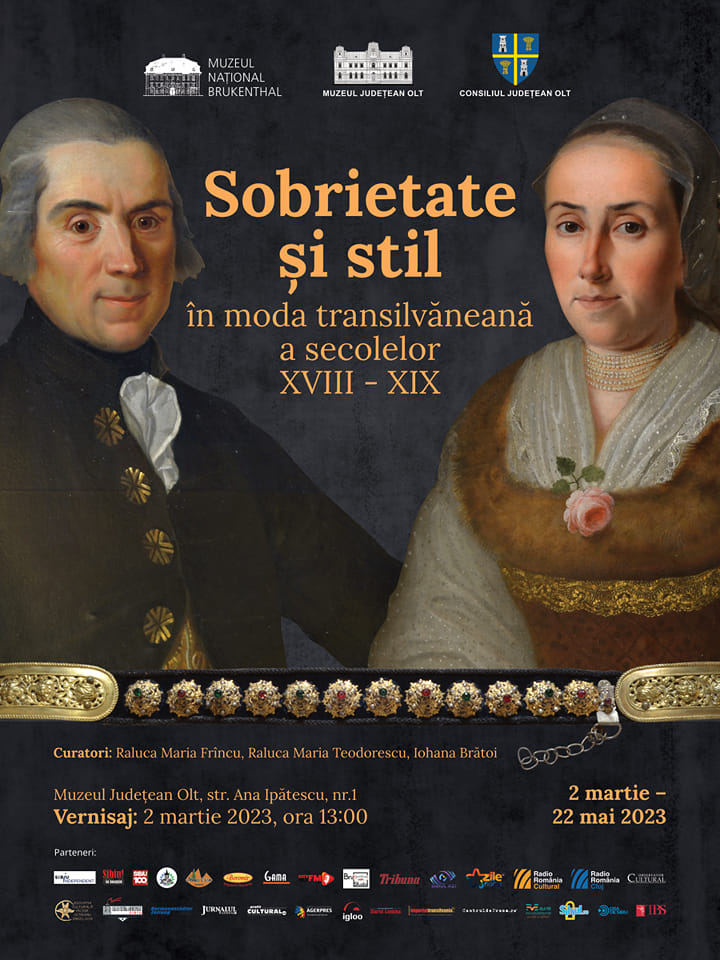
- Acest eveniment a trecut.
Slatina: Expoziţia „Sobrietate și stil în moda transilvăneană a secolelor XVIII-XIX”, Muzeul Județean Olt, 2 martie – 22 mai 2023
2 martie, 2023 - 22 mai, 2023

/RO/
Expoziţia: Sobrietate și stil în moda transilvăneană a secolelor XVIII-XIX
Locul de desfăşurare: Muzeul Județean Olt
Durata: 2.03-22.05.2023
Vernisaj: 2 martie orele 13.00
Partener: Muzeul Județean Olt
Curatori MNB: dr. Raluca Maria Frîncu, dr. Raluca Maria Teodorescu
Colaboratori: dr. Iulia Mesea
Conservatori: Ramona Muntean, Alexandra Runcan
Curator MJO: dr. Iohana Brătoi
Ace de voal, paftale şi cingători din aur şi argint bătute cu pietre preţioase, costume şi accesorii vestimentare, toate sunt semne ale dezvoltării economice pe care o atinseseră locuitorii din Transilvania în secolele trecute.
Preluând şi adaptând elemente din vestimentația occidentală, s-a creat o lume bazată pe sobrietate și stil. Acestea sunt motivele demersului nostru de a aduce în faţa vizitatorilor unele din cele mai spectaculoase elemente de vestimentaţie şi podoabă din lumea patriciatului săsesc din secolele XVII-XIX.
Pentru a stăvili luxul şi opulenţa aduse de suflul nou al modei vieneze, în anul 1752, Magistratul oraşului Sibiu a emis “Regulamentul ţinutei şi poliţiei”, care reglementa modul în care populaţia oraşului avea voie să se îmbrace în funcţie de clasa socială din care provenea. Cu acest prilej locuitorii Sibiului erau diferenţiaţi în nouă clase sociale. În regulament erau precizate pentru fiecare clasă în parte articolele vestimentare şi accesoriile care se cuveneau a fi purtate şi materialele din care acestea puteau fi confecţionate. Pentru că erau foarte greu de respectat prevederile acestui regulament, opt ani mai târziu, în anul 1760, a fost emis unul nou, mult mai sintetic şi moderat. Moda vremii dovedeşte însă că toate încercările municipalităţii de a opri cheltuielile exagerate ale populaţiei pe obiecte de lux şi de a diferenţia statutul social prin vestimentaţie s-au dovedit a fi zadarnice.
Dezbaterile despre o nouă reglementare a ţinutei au fost reluate la Viena în anul 1766, când breslaşii au încercat să promoveze textilele locale, dar împărăteasa Maria Theresia a interzis acest gen de regulamente, ceea ce a determinat încheierea epocii recomandărilor stricte în privința garderobei.
Expoziţia include 77 de piese din colecţiile Muzeului Naţional Brukenthal: Muzeul de Istorie Casa Altemberger şi Galeria de Artă Românească, având la bază un concept integrator şi interdisciplinar. Alături de tablouri de epocă, prin veşminte, podoabe şi accesorii din aceeaşi perioadă, cei interesaţi vor avea acces la o lume în care luxul şi eleganţa erau un mod de a trăi.
/EN/
Exhibition: Sobriety and style in the Transylvanian fashion of the 18th-19th centuries
Location: Olt County Museum
Duration: 2.03-22.05.2023
Opening: March 2 at 1 p.m
Partner: Olt County Museum
MNB curators: Dr. Raluca Maria Frîncu, Dr. Raluca Maria Teodorescu
Conservatori: Ramona Muntean, Alexandra Runcan
MJO Curator: Dr. Iohana Brătoi
Veil pins, sashes and belts made of gold and silver with precious stones, costumes and clothing accessories, all are signs of the economic development that the inhabitants of Transylvania had achieved in the past centuries.
Taking over and adapting elements from Western clothing, a world based on sobriety and style was created. These are the reasons for our approach to bring to the visitors` attention some of the most spectacular elements of clothing and adornment from the Saxon patriciate world of the 17th-19th centuries.
In order to stop the luxury and opulence brought by the new breath of Viennese fashion, in 1752, the Magistrate of Sibiu city issued the „Regulation of Dress and Police”, which regulated the way in which the population of the city was allowed to dress according to the social class they belonged to. On this occasion, the inhabitants of Sibiu were differentiated into nine social classes. The regulations indicated for each class separately the clothing and accessories that were supposed to be worn and the materials from which they could be made. Because it was very difficult to comply with the provisions of this regulation, eight years later, in 1760, a new one was issued, much more synthetic and moderate. However, the fashion of the time proves that all the municipality’s attempts to stop the population’s exaggerated spending on luxury and to differentiate social status through clothing proved to be useless.
Debates about a new dress code were resumed in Vienna in 1766, when the guilds tried to promote local textiles, but Empress Maria Theresia banned such regulations, ending the era of strict wardrobe recommendations.
The exhibition includes 77 pieces from the collections of the Brukenthal National Museum: Altemberger House History Museum and Romanian Art Gallery, based on an integrative and interdisciplinary concept. Along with vintage paintings, through clothes, ornaments and accessories from the same period, those interested will have access to a world where luxury and elegance were a way of living.